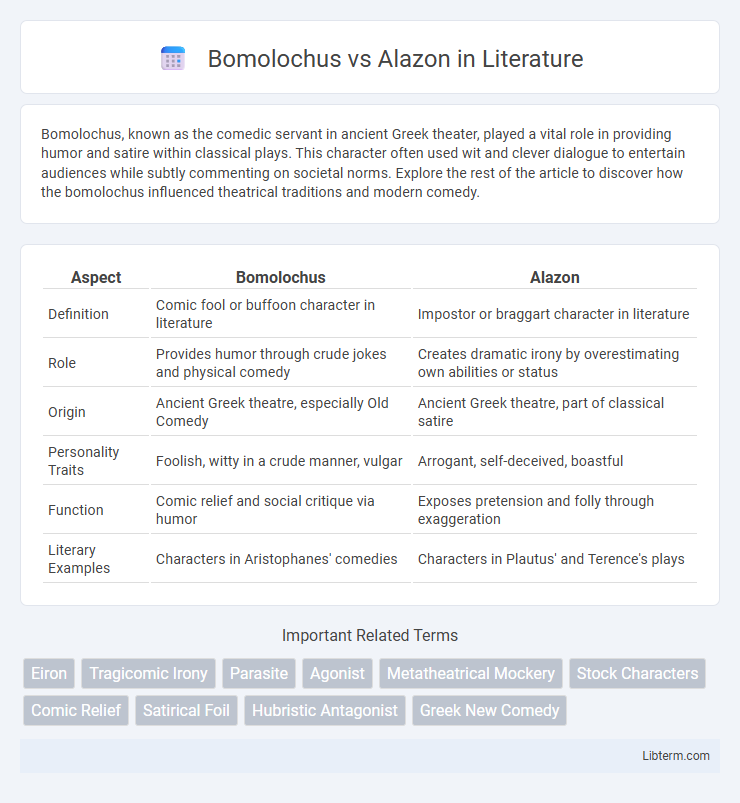Bomolochus, known as the comedic servant in ancient Greek theater, played a vital role in providing humor and satire within classical plays. This character often used wit and clever dialogue to entertain audiences while subtly commenting on societal norms. Explore the rest of the article to discover how the bomolochus influenced theatrical traditions and modern comedy.
Table of Comparison
| Aspect | Bomolochus | Alazon |
|---|---|---|
| Definition | Comic fool or buffoon character in literature | Impostor or braggart character in literature |
| Role | Provides humor through crude jokes and physical comedy | Creates dramatic irony by overestimating own abilities or status |
| Origin | Ancient Greek theatre, especially Old Comedy | Ancient Greek theatre, part of classical satire |
| Personality Traits | Foolish, witty in a crude manner, vulgar | Arrogant, self-deceived, boastful |
| Function | Comic relief and social critique via humor | Exposes pretension and folly through exaggeration |
| Literary Examples | Characters in Aristophanes' comedies | Characters in Plautus' and Terence's plays |
Introduction to Bomolochus and Alazon
Bomolochus and Alazon are key comedic archetypes in classical literature, representing contrasting social roles and behaviors. The Bomolochus embodies the witty, often lewd servant or clown known for sharp humor and physical comedy, while the Alazon is characterized as the boastful, self-deceived braggart who exaggerates his importance. Understanding these figures enriches the study of ancient Greek and Roman comedy, highlighting the dynamics of humor and social critique.
Origins and Definitions of Bomolochus
Bomolochus originates from ancient Greek comedy, specifically characterized as a buffoon or jester figure who uses crude humor and slapstick to entertain the audience. Unlike the Alazon, who is a deceitful, self-deceiving character embodying pretentiousness and false pride, the Bomolochus serves to provoke laughter through vulgar wit and physical comedy. The Bomolochus's role traces back to Old Comedy playwrights such as Aristophanes, where the character functioned as a source of comic relief and social critique by lampooning contemporary figures and behaviors.
Origins and Definitions of Alazon
The term "Alazon" originates from ancient Greek comedy and refers to a stock character who is an impostor or braggart, often exaggerating their own importance or abilities. In contrast, "Bomolochus" denotes a buffoon or clown figure known for crude humor and wit, serving as a comedic foil. The Alazon's role as a deceiver or self-deluded figure derives from classical theatrical traditions, deeply embedded in literary archetypes emphasizing pretense and folly.
Key Differences Between Bomolochus and Alazon
Bomolochus represents the comedic fool often characterized by slapstick humor and foolish antics, while Alazon embodies the confident impostor who deceives others with arrogance and false bravado. The Bomolochus typically elicits laughter through physical comedy and simple-mindedness, contrasting with the Alazon whose humor arises from exaggerated pride and pretentiousness. Key differences lie in their motivations: Bomolochus acts out of naivety or silliness, whereas Alazon's behavior is driven by a desire to appear superior or deceive.
Bomolochus: Role in Ancient Greek Comedy
Bomolochus served as the witty, vulgar stock character in Ancient Greek comedy, often acting as a servant or buffoon who used crude humor and clever wordplay to entertain the audience. This figure contrasted sharply with the Alazon, the boastful and pompous character whose exaggerated self-importance was frequently mocked. Bomolochus played a crucial role in providing comic relief and social commentary through satire and slapstick, highlighting everyday follies and human weaknesses.
Alazon: The Archetypal Braggart
The Alazon embodies the archetypal braggart, characterized by exaggerated self-importance and boasting about achievements or status that are often unfounded. This stock character, originating in ancient Greek comedy, contrasts sharply with the Bomolochus, who serves as the witty jester or clown. The Alazon's inflated ego drives much of the comedic tension, exposing human folly through overblown arrogance and pretentiousness.
Character Traits of Bomolochus vs Alazon
Bomolochus exemplifies the cunning trickster with traits such as wit, mischief, and a penchant for humor that disrupts social norms. In contrast, the Alazon is characterized by arrogance, self-deception, and boastfulness, often embodying the role of the braggart whose overestimation of abilities leads to eventual downfall. The dynamic between Bomolochus and Alazon highlights a thematic conflict where cleverness and street smarts challenge inflated pride and foolish pretense.
Bomolochus and Alazon in Classical Literature
Bomolochus and Alazon are prominent character types in Classical Literature, particularly in ancient Greek comedy and drama. Bomolochus represents the witty, often crude jester or comic servant who uses humor and physical comedy to entertain, while Alazon is typified as the boastful, self-deceiving impostor who exaggerates his abilities or status. These archetypes highlight social dynamics and human follies, with Bomolochus providing satire through cleverness and Alazon embodying hubris and self-delusion in theatrical narratives.
Influence on Modern Comedy and Storytelling
The Bomolochus character, embodying slapstick humor and physical comedy, directly influenced modern comedic archetypes seen in sitcoms and sketch shows, where exaggerated foolishness generates laughter. In contrast, the Alazon, characterized by deceit and self-deception, shapes contemporary storytelling through its role in dramatic irony and character-driven plots that highlight human folly. Both archetypes contribute to the complexity of narrative structures by blending humor with social critique, enriching modern comedy's thematic depth and audience engagement.
Conclusion: Enduring Relevance of Bomolochus and Alazon
The enduring relevance of Bomolochus and Alazon lies in their representation of universal human traits: the comic fool and the self-deceived braggart, respectively. Their archetypal roles continue to influence contemporary literature, theater, and psychology by providing insight into social dynamics and individual behavior. These characters remain essential for understanding humor, satire, and the complexities of human ego across cultures and time periods.
Bomolochus Infographic

 libterm.com
libterm.com